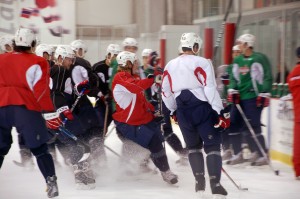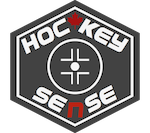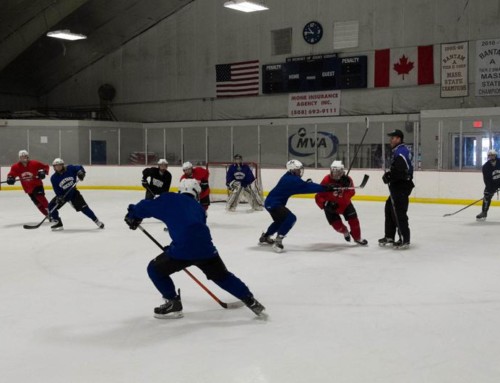
Photo by Teka England
One of the struggles a hockey coach faces over the course of a season is maintaining the players’ effort levels in practice and games from fall through spring. It’s a long season but, without consistently high levels of effort, the players and team will not reach their full potential. Their development and success are negatively impacted.
In team sports like hockey, understanding the potential cause of this reduction in effort from your players can go a long way in helping you recognize it quickly and make adjustments to prevent it from becoming part of the culture of your team.
A natural process when working as a group, is for individuals to exert less effort than they would working on the same task as an individual. Sport scientists refer to this as social loafing. It’s a very robust effect that researchers have found in a wide variety of environments from sport to business.
There are a number of reasons why social loafing takes place.
- In some cases, players want to save their best effort for when they perform on their own; where they feel their effort will stand out more and be recognized by coaches and other players.
- Other times, team members try to minimize their effort and get by with as little work as possible. They feel that as only one member of the team, their individual effort won’t be noticed by their coaches or teammates.
- Sometimes, players reduce their personal efforts in games and practices because they feel that they are dispensable. They feel that their contributions to the team aren’t valued by their teammates or coaches, so why bother trying.
- And, finally, individual players may reduce their effort level because they don’t want to provide a “free ride” to any of the less productive members of the team.
As a coach there are several things that you can do to try and limit the impact social loafing has on your team’s games and practices.
- Make individual players accountable for their effort or performance.
A considerable amount of loafing stems from a player’s belief that their level of effort is not being monitored. In the past, I’ve used a score sheet with my team, where I give an effort score for each player after every session – dryland, practice, and game. Depending on the age group and skill level, you can post this in the dressing/locker room or give it to each individual. It’s also important that the players know that there are consequences for poor effort and rewards for good effort. There has to be follow through. - Have individual rewards contingent on individual performance.
I’ve made the mistake before, as I’m sure many coaches have, of giving a team reward regardless of individual contributions. This type of reward system encourages social loafing. There’s no problem in having team rewards but it requires some thought to make sure that the players are clear that everyone must contribute equally towards it. - Discuss the role every team member plays on the team.
Every team member should be clear on the role they play on the team. How specific that role is, is dependent on the age group and skill level. Each player needs to know how they fit together with their teammates and how their specific role is important to the success of the team. As a coach, you should discuss this openly with the entire team several times throughout the season. Reinforce the importance of every role and every team member to the success of the team. - Build team cohesion
Having a cohesive team mitigates any effect social loafing may have on a team’s performance. When team members feel apart of the team they are more likely to follow team norms and expectations regarding effort and performance. They will hold each other accountable while working towards a common goal. Taking part in team building sessions early in the season can establish a tightly knit group that will be relatively resistant to social loafing through out the season. Team building should involve both social activities (e.g., team parties) and hockey specific activities (e.g., team goal setting).
I hope you find these suggestions helpful in working with your team over the course of the season. If you find that you have a couple of players who consistently give you less than their best effort, often all it takes is just a little effort on your part to let them know that your watching how hard they work and that you value what they contribute to the team.





Leave A Comment